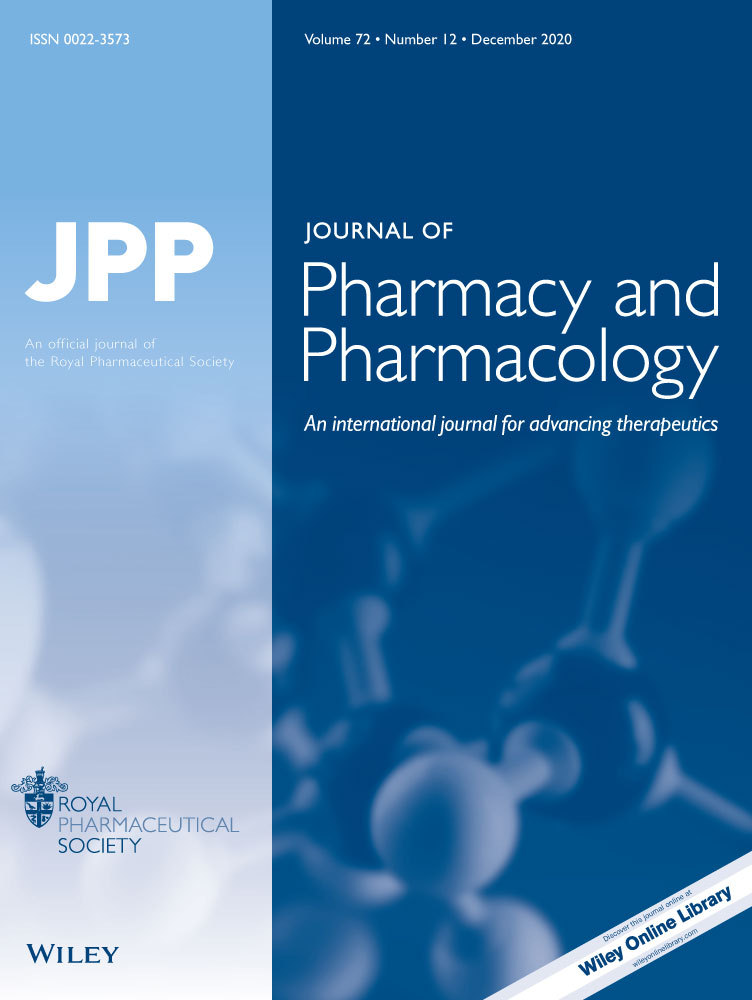Investigation of the Interaction Mode of Phenothiazine Neuroleptics with α1-Acid Glycoprotein
TOSHIMI MIYOSHI
Faculty of Pharmaceutical Science, Kumamoto University, 5-1 Oe-honmachi, Kumamoto 862, Japan
Search for more papers by this authorKATSUAKI SUKIMOTO
Faculty of Pharmaceutical Science, Kumamoto University, 5-1 Oe-honmachi, Kumamoto 862, Japan
Search for more papers by this authorCorresponding Author
MASAKI OTAGIRI
Faculty of Pharmaceutical Science, Kumamoto University, 5-1 Oe-honmachi, Kumamoto 862, Japan
Faculty of Pharmaceutical Science, Kumamoto University, 5-1 Oe-honmachi, Kumamoto 862, Japan.Search for more papers by this authorTOSHIMI MIYOSHI
Faculty of Pharmaceutical Science, Kumamoto University, 5-1 Oe-honmachi, Kumamoto 862, Japan
Search for more papers by this authorKATSUAKI SUKIMOTO
Faculty of Pharmaceutical Science, Kumamoto University, 5-1 Oe-honmachi, Kumamoto 862, Japan
Search for more papers by this authorCorresponding Author
MASAKI OTAGIRI
Faculty of Pharmaceutical Science, Kumamoto University, 5-1 Oe-honmachi, Kumamoto 862, Japan
Faculty of Pharmaceutical Science, Kumamoto University, 5-1 Oe-honmachi, Kumamoto 862, Japan.Search for more papers by this authorAbstract
Abstract— The interaction of phenothiazine neuroleptics with α1-acid glycoprotein (AGP) and desialylated AGP (asialoAGP) has been investigated by fluorescence, circular dichroism spectroscopy and by equilibrium dialysis. The binding parameters of phenothiazines obtained from fluorescence agreed closely with those obtained from circular dichroism and equilibrium dialysis. The binding affinities (nK) to AGP were slightly higher than binding affinities to asialoAGP. Attempts to correlate binding affinities with partition coefficients suggested that hydrophobic forces were mainly involved in the binding of phenothiazine neuroleptics to AGP and asialoAGP. However, electrostatic interaction was also found to be involved as suggested by experimental data obtained from the influence of oleic acid and caesium chloride on the drug binding to the two proteins.
References
- Aki, H., Yamamoto, M. (1989) Thermodynamics of the binding of phenothiazines to human plasma, human serum albumin and α1-acid glycoprotein: a calorimetric study. J. Pharm. Pharmacol. 41: 674–679.
- Aubert, J. P., Loucheux-Lefebvre, M. H. (1976) Conformational study of α1-acid glycoprotein. Arch. Biochem. Biophys. 175: 400–409.
- Brinkschulte, M., Breyer-Pfaff, U. (1980) The contribution of α1-acid glycoprotein, lipoproteins, and albumin to the plasma binding of perazine, amitriptyline, and nortriptyline in healthy man. Naunyn Schmiedebergs Arch. Pharmacol. 314: 61–66.
- Brunner, F., Müller, W. E. (1985) Prazosin binding to human α1-acid glycoprotein (orosomucoid), human serum albumin, and human serum. Further characterization of the 'single drug binding site' of orosomucoid. J. Pharm. Pharmacol. 37: 305–309.
- Brunner, F., Müller, W. E. (1987) The stereoselectivity of the 'single drug binding site' of human α1-acid glycoprotein (orosomucoid). Further characterization of the 'single drug binding site' of orosomucoid. J. Pharm. Pharmacol. 39: 986–990.
- Cho, M. J., Mitchell, A. G., Pernarowski, M. (1971) Interaction of bishydroxycoumarin with human serum albumin. J. Pharm. Sci. 60: 196–200.
- El-Gamel, S., Wollert, U., Müller, W. E. (1982) Optical studies on the specific interaction of dipyridamole with α1-acid glycoprotein (orosomucoid). J. Pharm. Pharmacol. 34: 152–157.
- El-Gamel, S., Wollent, U., Müller, W. E. (1983) Binding of several phenothiazine neuroleptics to a common binding site of α1-acid glycoprotein, orosomucoid. J. Pharm. Sci. 72: 202–205.
- Friedman, M. L., Schlveter, K. T., Kirley, T. L., Halsall, H. B. (1985) Fluorescence quenching of human orosomucoid, accessibility to drugs and small quenching agents. Biochem. J. 232: 863–867.
- Friedman, M. L., Wermeling, J. R., Halsall, H. B. (1986) The influence of N-acetylneuraminic acid on the properties of human orosomucoid. Biochem. J. 236: 149–153.
- Fujita, T., Iwasa, J., Hansch, C. (1964) A new substituent constant, π, derived from partition coefficients. J. Am. Chem. Soc. 86: 5175–5180.
- Helmer, F., Kiehs, K., Hansch, C. (1968) The linear free-energy relationship between partition coefficients and the binding and conformation perturbation of macromolecules by small organic compounds. Biochemistry 7: 2858–2863.
- Hulshoff, A., Perrin, J. H. (1977) Quantitative correlations between albumin binding constants and chromatographic RM values of phenothiazine derivatives. J. Med. Chem. 20: 430–439.
- Kremer, J. M. H., Willting, J., Janssen, J. H. M. (1988) Drug binding to human alpha-1-acid glycoprotein in health and disease. Pharmacol Rev. 40: 1–47.
- Maruyama, T., Otagiri, M., Takadate, A. (1990) Characterization of drug binding sites on α1-acid glycoprotein. Chem. Pharm. Bull. 38: 1688–1691.
- Moriguchi, I., Kanada, Y., Komatsu, K. (1976) Van der Waals volume and the related parameters for hydrophobicity in structure-activity studies. Chem. Pharm. Bull. 24: 1799–1806.
- Otagiri, M., Maruyama, T., Imai, T., Imamura, Y. (1987) Fluorescence investigation of binding of phenprocoumon to α1-acid glycoprotein. J. Pharm. Sci. 76: 646–649.
- Otagiri, M., Yamamichi, R., Maruyama, T., Imai, T., Suenaga, A., Imamura, Y., Kimachi, K. (1990) Drug binding to α1-acid glycoprotein studied by circular dichroism. Pharm. Res. 6: 156–159.
- Piafsky, K. M. (1980) Disease-induced change in the plasma binding of basic drugs. Clin. Pharmacokinet. 5: 246–262.
- Primazic, S., McNamara, P. J. (1985) Effect of the sialylation state of α1-acid glycoprotein on propranolol binding. J. Pharm. Sci. 74: 473–475.
- Rosen, A. (1970) The measurement of binding constants using circular dichroism. Biochem. Pharmacol. 19: 2075–2081.
- Routledge, P. A. (1986) The plasma protein binding of basic drugs. Br. J. Clin. Pharmacol. 22: 499–506.
- Schley, J., Müller-Oerlinghausen, B. (1986) Investigation of the binding of various tricyclic neuroleptics and antidepressants to α1-acid glycoprotein. J. Pharm. Pharmacol. 38: 102–106.
- Urien, S., Albengres, E., Zini, R., Tillment, J. P. (1982) Evidence for binding of certain acidic drugs to α1-acid glycoprotein. Biochem. Pharmacol. 31: 3687–3689.
- Warren, L. (1959) The thiobarbituric acid assay of sialic acids. J. Biol. Chem. 234: 1971–1975.
- Weber, G., Young, L. B. (1964) Fragmentation of bovine serum albumin by pepsin. J. Biol. Chem. 239: 1415–1423.
- Whelpton, R. (1989) Ionization constants, octanol partition coefficients and cholinesterase inhibitor constants for chlorpromazine and its metabolites. J. Pharm. Pharmacol. 41: 856–858.




